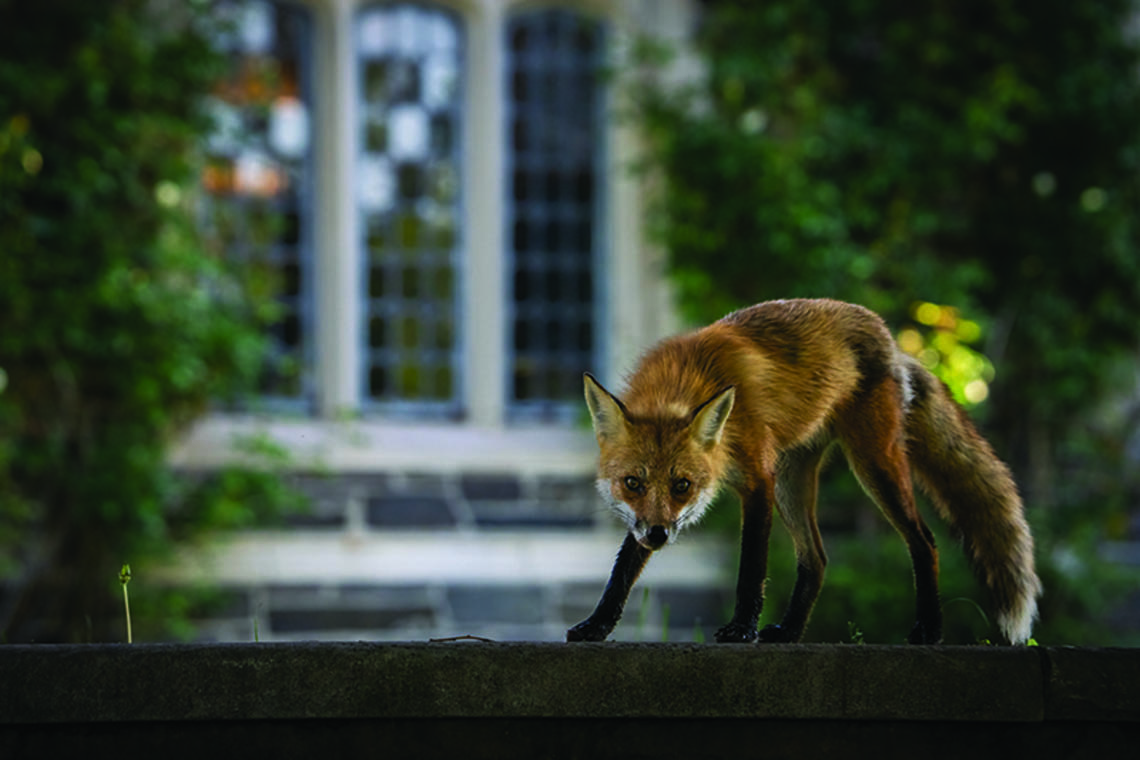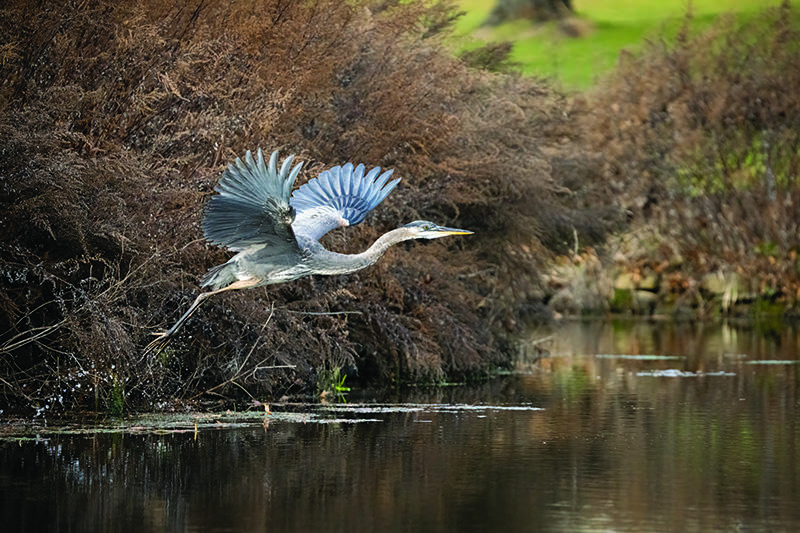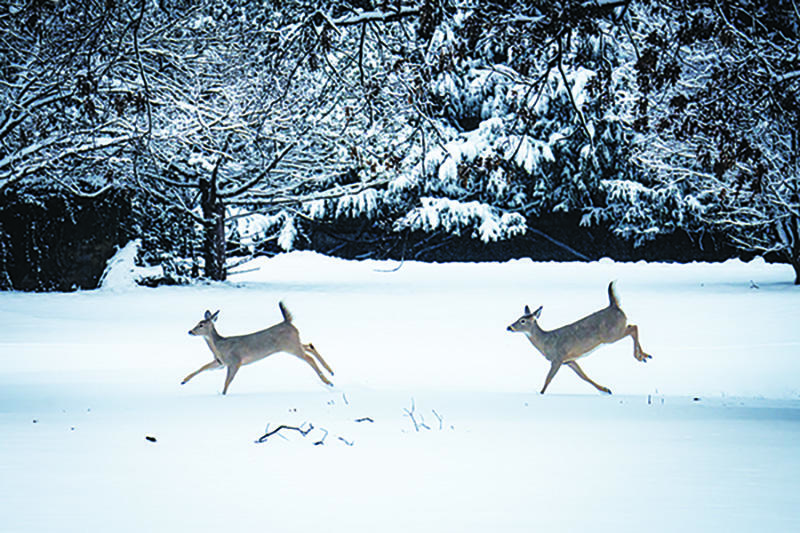

As brochures and Commencement speeches tell us, it’s the people who truly make Princeton Princeton. Amid the sea of undergraduates, equal parts electric scooters and sweatpants; graduate students, running on espressos and angst; faculty, probably in tweed; and staff, holding everything together, Princeton is defined by the meaningful interactions that occur between its inhabitants, they say. But amid this hubbub, it is easy to overlook Princeton’s multitude of other residents. The pair of peregrine falcons that roost on the wings of Fine Hall, littering the ground with remnants of their daily menu (favorite dishes include the northern flicker, American woodcock, and mourning dove). Or the blue heron in the pond of the Springdale Golf Club, dutifully and diligently on mice patrol around the clock. Or the fearless red-tailed hawks that routinely swoop in and out of campus trees and buildings; not one of Princeton’s omnipresent squirrels is safe. Even the hordes of deer soliciting staring contests and armies of Canada geese looking for a fight by the canal.
And most famous of all, the elusive but ever-present Princeton Fox; a red fox (Vulpes vulpes) that has made campus its home for the last few years. Go on a few strolls in the gloaming, and you just might bump into this institutional icon, strutting around as smug as any Princeton admit and equally decked in orange and black. Since its official residency, the Princeton Fox has made a name for itself, trending as both a hashtag and a proper noun, and is constantly sighted by students and staff, sauntering about Princeton’s ivy-draped architecture.
Animals are forced to constantly adapt to survive and thrive in a human-dominated world, and the least we can do is respect and appreciate our colliding worlds.
When I graduated with an A.B. in 2016, the fox had yet to make its debut anywhere in town. During my time away, I spent a year teaching at a boarding school in southern Thailand; a year in the Ethiopian highlands studying a herd of wild gelada monkeys; and months in a tent thru-hiking the mountain crests of California, Oregon, and Washington. Upon my return in 2019 to pursue a Ph.D. in the School of Public and International Affairs, pretty little Princeton felt pretty out of place. Muttering about how nice certain patches of campus grass would be to camp on was not conducive to a suburban (or sane) student lifestyle, and neither was retiring for bed at “hiker midnight,” aka 9 p.m. Nor did either make fast friends.
But my delightful discovery of the Princeton Fox soon turned things around. I quickly struck up at least a one-way friendship with my newfound vulpine friend, who was particularly drawn to the naturally-occurring edge habitat that Princeton’s assortment of structures and sylvan stretches emulated so well. Concomitantly ditching friends and commitments to make my daily fox rendezvous augured what was to come, and things soon spiraled out of control. More than once I’d find myself lying in wait on the golf course, sometimes before sunrise, garbed in full ghillie suit and camo pants, wondering how my life got to this point. From my near-decadal stint as a Princeton student, I had fully evolved from an undergraduate bemoaning “those weird graduate students” to said weird graduate student and true wildlife paparazzo.
But in the words of a literary idol, it is also true that, “if you walk the footsteps of a stranger, you’ll learn things you never knew you never knew.” Disney’s Pocahontas might not have been referencing Princeton’s urban wildlife, but intertwining my life with that of the Princeton Fox has taught me so much. For one, he keeps a stricter daily regimen than I do, and consistently cycles through the same few sites to sunbathe and hunt, especially around dawn and dusk. Another revelation is that the Princeton Fox has since franchised into several fox families, or skulks, all with distinct dens around campus and little pups to herald the spring early each year. And the magical little moments of interaction; foxes now periodically come to within feet of the weirdo in camo, inordinately curious of the little twigs I snap and gently toss their way.
The Princeton Fox and friends (strictly nonpartisan) are also emblematic of larger issues at play. Land is finite, and development at all scales is largely a zero-sum game. When land use encroaches on natural habitats, there are species that win and lose, and humans are the only consistent victors. This is likely why Princeton would do well if U.S. News ever released a “Best Campus Wildlife” ranking, but these same reasons are also driving increased human-wildlife conflicts across the country and all over the world.
At Princeton, institutional decisions for construction and expansion affect the thousands of transient students, scholars, and staff that make up the institution at any one time, but they affect just as much the silent majority of those with no say in which patches of land are next to be razed or renovated. Animals are forced to constantly adapt to survive and thrive in a human-dominated world, and the least we can do is respect and appreciate our colliding worlds. Between staying out, sleeping in, socializing, or anti-socializing, it might also serve your sanity and conscientious citizenship to immerse yourself every so often in the rich tapestry of parallel lives that also call these historical arches and shrinking verdant spaces home. But if you do approach the Princeton Fox, tread softly, and only carry small sticks.












3 Responses
Rick Mott ’73
2 Years AgoAnother New Jersey Fox Friend
I thoroughly enjoyed Bing Lin's story about the Princeton Fox, and would like to introduce him to mine. He appeared last October, trotting across the yard from behind the neighbor’s woodpile in broad daylight like he owned the joint to our bird feeders 15 feet from our south-facing dining room windows. I don’t think of foxes as being much interested in birdseed, but he clearly wasn’t after birds. He was looking for stuff on the ground. My Maryland cousin who lives in fox country explained it when I talked to her later. The seed mix I scatter for the ground feeders includes some raisins and dried fruit, which foxes apparently love. He was having a nice mid-morning snack on a sunny fall day.
Norman Ravitch *62
2 Years AgoWho Is Transient?
I love the author calling students transient and the animals real residents.
Frank Strasburger ’67
2 Years AgoSheer Poetry
What a joy to read Bing Lin’s artful reverie about the Princeton Fox and the place in the University’s ecology of the “silent majority” of creatures who share the campus — or, rather, with whom we share it. They were here first, relatively less visible though they be, and as Lin reminds us, our lives are enriched when we yield to them their rightful place.